Another recent beneficiary of the current round of BU Graduate School Santander Mobility Awards is Higher Education Academy (HEA) funded PhD student David Galley. His study has attracted funding of £1000 allowing him to travel on fieldwork to other universities around the UK, seeking the perceptions of male social work students on their journeys through qualifying programmes.
The PhD thesis research of David Galley is based on male student’s perceptions of the lack of male practitioners in social work practice in the UK, why those males who undertake qualifying degrees enter the profession, and what their experiences are of what has been described as ‘pedagogically feminised’ programmes. His mixed-methods study will examine current and established perceptions which may inform future social work curricula. His research is supervised by Prof Jonathan Parker and Dr Sara Ashencaen Crabtree who have both researched and published in this area. 
Category / Communities, Cultures and Conflicts
New research web pages and removal of old pages
On Monday 27 January the Digital Communications Team will integrate the new research web pages into the main BU site.
This will include a link from the homepage and from the School pages. (School copy has been developed with the Deans and DDRs to introduce the new site, provide an overview of the School’s research and outline the research themes the School is involved in).
The Digital Communications Team will also start removing the old research pages on Monday. This will include removing the research centre pages, which have either been moved to the new site, elsewhere, or identified as no longer required.
In addition to notification from Professor Matthew Bennett and the Schools, the research website team have tried to speak to all staff in person to ensure required content is moved across and outdated content is removed. This has been a massive exercise and apologies if we have missed anyone. If you do have any concerns regarding your pages, please email the website team as soon as possible. All old content will be moved onto an internal BU server, where it will be kept for a period of six months before being finally deleted.

Feedback from researchers already using the new site is that it is very flexible, quick and easy to use and allows easy integration of a variety of different media content types.
If you would like to find out more about using the new site or joining us for a training session, please read my blog post from earlier in the week.
Good start of the year: Early crop of 2014 publications

HSC staff saw the fruit of their hard work in 2013 as a great number of papers have been accepted for publication or actually appeared in print in the first three weeks of January.
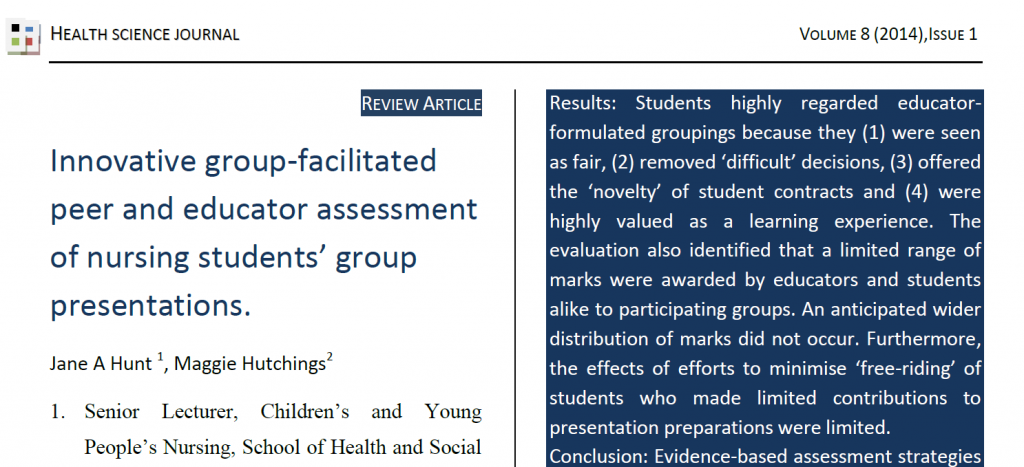
There are a number of 2014 papers in health care journals, including papers in Nurse Education in Practice, The Practising Midwife, Journal of Clinical Nursing, Birth, ISRN Family Medicine, Perspective in Public Health, an editorial in Midwifery and two in the same issue of Health Science Journal. There was also an early contribution from our social science colleagues in The Journal of Adult Protection and, last but not least a book chapter in Case Studies in e-Learning Research.
- Morley, D., 2014. Supporting student nurses in practice with online communication tools. Nurse Education in Practice, 14, 69-75.
- Bennett, S and Scammell, J (2014) Midwives caring for asylum-seeking women: research findings. The Practising Midwife. 17 (1) p9-12
- Whitford, H., Aitchison, P., Entwistle V.A., van Teijlingen, E., Davidson, T., Humphrey, T., Tucker, J. Use of a birth plan within woman-held maternity records: a qualitative study with women and staff in northeast Scotland, Birth (accepted).
- Norton, E. 2014 The application of humanization theory to health-promoting practice. Perspectives in Public Health, (online first 2013)
- Sapkota, T., Simkhada, P., van Teijlingen, E. (2014) Nepalese health workers’ migration to the United Kingdom: A qualitative study. Health Science Journal 8(1): 57-74.
- Hunt, J.A., Hutchings, M. (2014) Innovative group-facilitated peer and educator assessment of nursing students’ group presentations, Health Science Journal 8(1): 22-31.
- Harding, A., Sanders, F., Medina Lara, A., van Teijlingen, E., Wood, C., Galpin, D. Baron, S., Crowe, S., Sharma, S. Patient choice for older people in English NHS primary care: theory & practice, ISRN Family Medicine (accepted).
- Norton, E., Holloway, I., Galvin K. 2014. Comfort vs risk: a grounded theory about female adolescent behaviour in the sun. Journal of Clinical Nursing. (online first 2013)
- van Teijlingen, E., Hundley, V., Matthews, Z., Lewis, G., Graham, W.J., Campbell, J., ten Hoope-Bender, P., Sheppard, Z.A., Hulton, L. (2014) Millennium Development Goals: All good things must come to an end, so what next? Midwifery 30: 1-2.
- Parker, J., Ashencaen Crabtree, S. (2014) Covert research and adult protection and safeguarding: an ethical dilemma? The Journal of Adult Protection (accepted).
- Hutchings, M, Quinney, A., Galvin, K. Clark, V. book chapter IN: ‘The Yin/Yang of Innovative Technology Enhanced Assessment for Promoting Student Learning’ Case Studies in e-Learning Research. Book is now available at: http://www.academic-bookshop.com/ourshop/prod_2915879-Case-Studies-in-eLearning-Research-for-Researchers-teachers-and-Students.html
Prof. Edwin van Teijlingen
Centre for Midwifery, Maternal & Perinatal Health
NRG talk on Victorian narratives of motherhood
We are delighted to announce that Professor Emma Griffin from the University of East Anglia will be presenting a paper to the Media School’s Narrative Research Group as part of this semester’s series of talks. The title of Emma’s paper is ‘Victorian Mothers: perspectives from working-class autobiography’, and the full abstract for Emma’s talk appears below. The event will take place at 4p.m on 5 Feb in the Casterbridge suite. All welcome.
Abstract:
Historians like to imagine that emotions such as maternal love are largely constant across time and space. They argue that mothers in earlier times loved their children in much the same way as we do today, though they accept that love was often expressed in different ways. This paper turns to working-class autobiography to consider these claims. It asks how the emotional ties of family life were expressed and sustained in households where space and resources were scarce. It concludes that material deprivation had the power to undermine family relationships in ways that historians have usually been reluctant to admit.
Research website training sessions
BU’s new research website is an externally facing communications channel. It allows you to add and update research-related content quickly and easily. The site is flexible and accommodates a range of digital media content. You can login with your usual BU username and password and start creating content here.
We are hosting a series of 90 minute training sessions, which are open to all BU academic staff, post graduate research students and those supporting researchers in their communications activity.
During the session you will learn the following:
- Why BU has a new research website
- How you can upload content to the website
- How the site can be used most effectively to maximise exposure of BU research.
There are three sessions taking place next month on Talbot Campus and at the Lansdowne. These are hosted by the website designer Matt Northam and me. Sessions are informal and if they fall over lunchtime, do feel free to bring a sandwich!
To book on one of the following sessions please use the links below…
Friday 7 February 2014 12:00-13:30 – S103 Studland House, Lansdowne Campus
Friday 14 February 2014 10:00-11:30 – P131 Poole House, Talbot Campus
Friday 14 February 2014 14:30-16:00 – P131 Poole House, Talbot Campus
If you have any questions about the website or training sessions, please email the research website team.
BU Social Science Study Leave at Universiti Kebangsaan Malaysia
Just one week into our fusion-funded study leave and work is developing, growing and coalescing around the objectives we set and negotiated last June and July.
We arrived in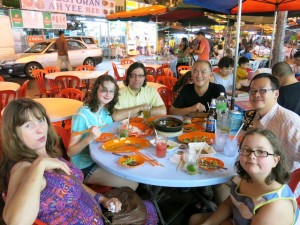 Kuala Lumpur last Saturday evening (11th Jan), stumbling into our hotel after the 11-hour flight having watched the films Rush and one featuring an improbably accident prone and deranged Sherlock Holmes character, with the children glued to Cloudy with a Chance of Meatballs 2.
Kuala Lumpur last Saturday evening (11th Jan), stumbling into our hotel after the 11-hour flight having watched the films Rush and one featuring an improbably accident prone and deranged Sherlock Holmes character, with the children glued to Cloudy with a Chance of Meatballs 2.
Sunday 12th January took us straight into our first meeting, after a brief punctuation for swimming, to discuss the plight of the Jakun, a tribe of the Orang Asli (first people), living at Tasik Chini, one of only two natural freshwater lakes in Peninsula Malaysia. The effects of mining, concomitant environmental damage, the needs of the people and some of the perceived tensions between those working and researching with the Orang Asli were described.
Our thoughts concerning the plight of the Orang Asli were further agitated by discussion with the social science team, the meeting being chaired by Prof Dato’ Mushrifah Idris, the head of the Tasik Chini Research Centre at Universiti Kebangsaan Malaysia (UKM – National University of Malaysia) of which we are honoured to be visiting professors. The mining activities have expanded significantly since we last met with Prof Mushrifah in summer 2012 and the outlook for the already resettled Orang Asli seems increasingly bleak.
A large part of our work whilst we are with UKM is to assist with the research. We were heartened to learn of the formation of the social science team within the Tasik Chini Research Centre since our earlier discussions with Prof Mushrifah, a natural scientist. Discussion centred on the fact-finding work and concern to illuminate the perceptions of the Orang Asli, our particular contribution being to consider how we can elicit the stories, beliefs, wants and needs of an increasingly voiceless people.
Over the next few weeks we will be making introductory visits and meeting people who work alongside these groups as advocates and welfare workers. The social science team also want us to work with their social work and sociology student groups to help develop a community development approach at the Tasik Chini site. It was suggested that a Participatory Action approach would probably be the best way forward where community members act as equal partners with academic staff and students to identify needs and solutions.
From the first meeting onwards, we also discussed some of the fears expressed about developments in social work education and practice as Malaysia moves slowly towards passing, and subsequently, implementing its Social Work Bill. A new college initiative is being proposed to address some of the anxieties of non-social work graduates and many NGOs regarding the concern that they will be marginalised by graduate social workers solely benefitting from social work becoming a protected title. We have been asked to advise on the curriculum in this venture.
We were also invited to assist in the development of a new Master’s programme in social work at UKM, determining whether a niche in medical sociology and social work or an emphasis on marginalised and disadvantaged groups would play best to strengths. Prof Vishantie Sewpaul, vice president of the International Association of Schools of Social Work and Kwa-Zulu Natal South Africa, and ourselves joined the UKM team in exploring how they might best develop the academic elements and niche areas. This will involve further discussion but was given a boost the following day (Thurs 16th) at a special colloquium at the Institut Sosial Malaysia, in which we advised on publication and research strategies.
In between this work, background reading, catching up with emails (when we can as email connection is sporadic!) trying to swat mosquitoes, find food and locate a local launderette – and generally navigate our way around on foot in a largely non-pedestrian society where wheels are essential, we are also busily educating our children. In many ways this provides an important balance and helps us in engaging with our family-friendly hosts!
We have also been delighted to meet our former Malaysian students attending the meetings that we have each respectively taught over the years at Universiti Malaysia Sarawak and at University of Hull, who have now reached positions of prominence in their chosen professions. We were both astonished to find out that so many people we have met this week were not only were aware of our individual previous research but were able to refer knowledgably to a number of our papers that relate to the Malaysian context.
So early days and only one week in; but already there are signs of meeting those key fusion objectives of developing international research links, educational opportunities that may link to professional practice outcomes.
Jonathan Parker & Sara Ashencaen Crabtree
Atrium BRC stand
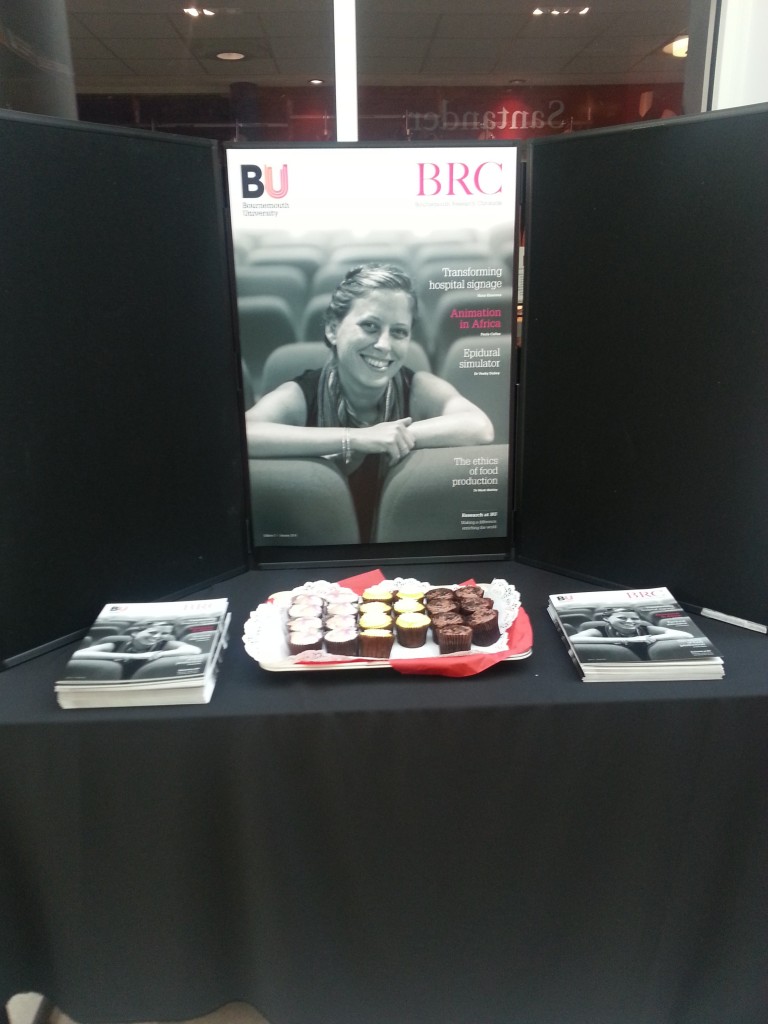
Emily Loring and I are in the Atrium, Poole House, Talbot Campus today giving out copies of the Bournemouth Research Chronicle (BRC) magazine to academic staff. Do come along and pick up a copy and have a cake with us!
We will be here until 4:30pm today (Tuesday) and again on Thursday between 9am-5pm.
Real Lives, Celebrity Stories Book Launch 29 January
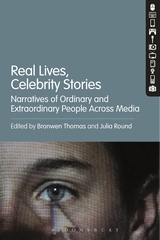
To celebrate the publication of Real Lives, Celebrity Stories, edited by Bronwen Thomas and Julia Round, the Media School’s Narrative Research Group will host a book launch at 3 p.m on 29 January in the Casterbridge suite. Featuring contributions by several colleagues from the Media School, including Shaun Kimber, Peri Bradley, Darren Lilleker and Sue Thomas, the book was inspired by the first symposium organised by NRG back in 2010 and explores narratives of ordinary and extraordinary people in television, film, fan cultures, comics, politics and cyberspace. At the launch, the editors and contributors will provide a brief introduction to each of their chapters, and light refreshments and wine will be provided. All welcome.
Bournemouth Research Chronicle
The third edition of the Bournemouth Research Chronicle (BRC) is now published. Thank you very much to everyone who contributed.
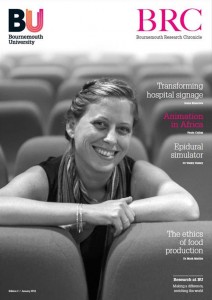
This is a glossy ‘coffee table’ magazine with some lovely images. It is aimed at peer researchers and research collaborators, prospective funders and (perhaps most importantly) research users such businesses, government organisations, policy makers and charities.
We all know that communication is an integral part of the link between research and societal impact and this magazine is a great way to get the message heard by the right people.
Content is presented through BU’s eight research themes. This edition provides a snapshot of some of the work BU submitted to the Research Excellence Framework (REF) 2014. In particular it focuses on the societal impact of our research, which forms a key part of REF2014.
Distribution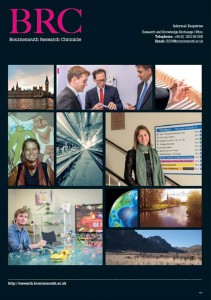
Every BU academic will receive a copy of the BRC. My colleagues and I will be in the Atrium, Poole House on Tuesday and Thursday next week with a large stash so do pop along, say hello and pick up yours. Otherwise, we’ll put it in the internal post for you.
Throughout January I’ll be sending the BRC to an extensive list of research users, including policy makers, community figures, opinion leaders, businesses and journalists. I will be providing a supply to each School so please do send it to your contacts, collaborators, peers, prospective funders, industry partners or anyone else who has an interest in BU’s research.
R&KEO will keep a larger stock of the BRC. If you would like copies for an event or conference then email me (Sally Gates – Editor) to arrange a delivery.
Thank you again to everyone who contributed and happy reading!
ARTS in RESEARCH (AiR) Group Forming
We are pleased to announce the formation of the Arts in Research (AiR) Group. This effort grows out of the experience of HSC’s ReThink process and previous work at HSC in using tools from the Arts in carrying out research, disseminating findings and sharing them with students, colleagues and communities beyond the University. The Group is open to members of any School with an interest or even curiosity in how they might infuse their interest in the arts within more routine research and/or presentation practices.
The interest in Arts-based Research is international and growing. Areas such as video, film, photography, dance, drama, poetry, radio production, creative writing—even clowning—are becoming more mainstream. Conferences, for example, no longer routinely consist of hour-after-hour packed with 20-minute PowerPoint presentations. Young students balk at PPT and expect more creativity from lecturers in their learning experiences. Reaching wider audiences (including ‘service-users’ and the public) is now routinely demanded by funding bodies. Tools from the Arts can greatly enhance all of these efforts.
Using Arts-based approaches in research requires thinking about Method from novel viewpoints. Involving research participants in producing outputs frequently enlivens projects, for one example. Finding the right arts-based method for the research questions or findings is key to their use. Finding the right collaborator for your project can be central to its success.
The ARTS in RESEARCH (AiR) Group will begin meeting in January (watch for announcement by email, Facebook and Twitter). We will begin by exploring what interests group members have and what resources are already available. We will also explore the possibility of collaborations with working artists, so no need to feel that great personal skill is required, just enthusiasm.
Please contact Kip Jones (kipworld@gmail.com) if you are interested in joining the group.
What’s the Centre for Social Work, Sociology & Social Policy up to?
Read what the Centre has been doing over the last year by clicking on the link to a PDF of our latest newsletter.
In the Centre we are rightly proud of the achievements of our students and their engagement in public activities and international opportunities, as well as those of our staff. It is through our newsletter that we keep our colleagues, here in the UK and internationally, abreast of our activities. We thought you would want to share in this.
In this edition you will find articles on student international placements in Malaysia, our hosted international week, and our new Sociology & Anthropology programme. There is information about conference presentations undertaken by Centre members, and introductions to some of the exciting and innovative social science research conducted within the Centre.
Should you want to find out more, to collaborate with members on research projects please get in touch with any of us.
Dr. Anna Feigenbaum Wins AAG Enrichment Grant

The Association of American Geographers (AAG) has awarded an annual meeting grant to Dr. Anna Feigenbaum, lecturer in Media and Politics at the Media School. AAG Enrichment Funds “support participation of distinguished non-geographers in the annual meeting,” helping to promote cross-disciplinary knowledge exchange between geography and other fields of study. Dr. Feigenbaum will travel to Tampa, Florida in April 2014 to deliver a presentation on her Tear Gas project in preparation for her monograph on the subject due out with Verso in 2015. She will also participate in the ‘subconference’–a set of meetings within the meeting focused on collaboration and skill-sharing. As part of the ‘Professional and intellectual triage for emerging and early career scholars’ panel, Dr. Feigenbaum will offer guidance on moving through the first years of academia in these times of precarity and change in the HE sector.
Password? Not another one!
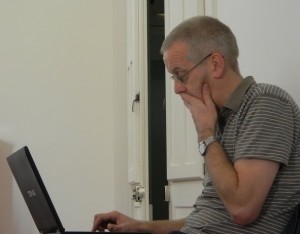
The increasing volume of academic activity on the internet coupled with a growing obsession about privacy and data protection means for many academics a rapidly expanding number of online accounts and associated passwords. This is, of course, over and above our regular dose of accounts and passwords as citizens of the virtual world. The average adult in the UK must have at least 25 internet accounts, for the bank/building society, supermarkets, phone companies, social media, airlines, trains, insurance companies, eBay, the website of the parents’ council of your children’s school, your electricity provider, the council tax, etc.
I feel as an academic, the burden is even worse. Every single time another scientific journal invites me to review a paper it opens an on-line account for me. Every time I apply for a grant from a funding body to which I have not previously applied, I am required to set up an account with a new password. When you apply for 20-odd grants every year and review manuscripts for a similar number of different journals the number of accounts and passwords add up rapidly. Then there are the other accounts and passwords related to work for sites such as this BU Research Blog, BRIAN, Survey Monkey, for the university for whom you act as external examiner, for Drop Box, the British Library, ORCIC, ACADEMIA.EDU, ResearchGate, Researchfish, Linkedin, and the list goes on.
These last few months I was reminded how non user friendly some systems are. First, I received new secure email account for my part on a REF sub-panel. The account name chosen for me is different from what I would have chosen and what I am used to at Bournemouth University. The importance of confidentiality for the REF work is clear so my password has to be different from anything I use elsewhere. Secondly, a few weeks later I attempted to put my name done for the tri-annual conference of the International Congress of Midwifery in Prague next year. It turns out you cannot join the conference without opening an on-line account first. The account name was automatically chosen for me and so was the password. Unfortunately, both are impossible to remember, neither the account name nor the password (which was case sensitive) were ones I would have selected personally.
There is some hope as some journals allow you to choose your own account name and password. Elsevier has brought most of its journals into one account, with your own email as the account name and all with the same password. Similarly a group of English-language journals in Nepal called Nepal Journals OnLine (NepJOL) use one account name for all participating journals. For the rest of my account names and passwords I can only follow the advice given by Stephen Fry on an episode of QI: “Write it down somewhere on a piece of paper”. The underlying idea is that the people who try to steal your internet account details sit in a bedsit in London or Hong Kong and won’t come to your office or living room to steal a piece of paper with computer addresses. The people who try to break into your house or office are looking for objects with a street value, such as your TV, phone or laptop, they are generally not interested in a piece of paper with some scribbles on it.
Prof. Edwin van Teijlingen
Centre for Midwifery, Maternal & Perinatal Health
The “Spirit of 13”
The outcomes of CEMP’s Spirit of 13 inter-generational research project are now online.
The screening and forum event with Ken Loach, hosted by the British Film Institute, was the outcome of a project for which people aged 25 and under produced inter-generational documentary films in response to Loach’s ‘The Spirit of ’45’. CEMP collaborated with Sixteen Films, the BFI, the Media Education Association and Media Magazine.
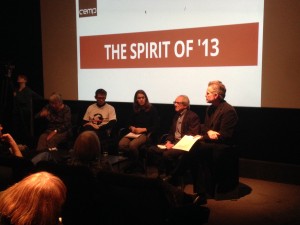
We are grateful to Daniel Weissman and his production crew and to Trevor Hearing, for support.
ILA Committee on Nuclear Weapons, Non-Proliferation and Contemporary International Law to present final report and draft resolution in Washington in 2014
A specialist Session at the Washington Conference will be devoted to Legal Aspects of Nuclear Disarmament and to discuss future activities to be taken under the Committee’s mandate, ‘to consider legal approaches to non-proliferation and regulating nuclear weapons within the contemporary context and, ultimately, to present options for future legal cooperation in this field’.
The Committee has compiled a report on the subject and drafted a draft resolution for consideration. The work of ILA as a scholarly NGO and its Committees often feeds into lawmaking at the UN.
Dr.Sascha-Dominik Bachmann, Associate Professor in the Department of Law, is a member of the British section (http://www.ila-hq.org/en/committees/index.cfm/cid/1025/member/1) and has been part of the on-going Committee work since 2010.
field’.
Media and Information Education in the UK: Recommendations to the European Union
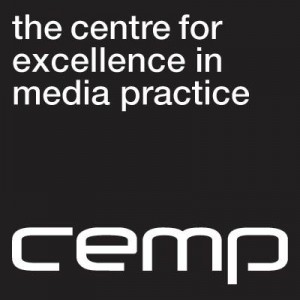
Dr Julian McDougall from BU’s Centre for Excellence in Media Practice (CEMP) will make recommendations on UK media education at a conference in Paris later this month.
The conference brings together comparative analyses on media and information education from EU member states and Dr McDougall will present the UK report alongside his London School of economics (LSE) research collaborators.
Dr McDougall said: “In the UK report, we have mapped media education provision in the UK against the various EC and EU frameworks and draw a clear conclusion, that the UK is rich with expertise, energy and leadership for media and information education, and to a significant extent is the envy of other European nations in this respect, but deeply entrenched prejudice against ‘media studies’ means that promoting media literacy through schools is continually undermined.”
The report examines the progression of media education through three key phases:
- Pre-OFCOM: the establishment of Media Studies, Film Studies and other related areas in the curriculum.
- 1997 – 2011 New Labour Government and OFCOM media literacy intervention with some correspondence to Media Studies
- Post-OFCOM Coalition Government, discontinuation of media literacy strategies
When examining the current ‘state of play’ in UK media literacy education, Dr McDougall and his colleagues looked at four areas: the study of media in formal secondary and higher education through curriculum subjects such as Media Studies, Film Studies and Media/non-literary textual analysis in English as well as vocational courses; broader, less formal examples of media literacy across the UK curriculum and extra-curricular activities such as literacy education in primary schools and related subjects like Citizenship, Sociology and History; e-safety policies in the school system; and media & information literacy outside of formal education.
Having examined the current scope and provision of UK media education and media literacy, the report identifies a scarcity of funding and training and a contradiction between support for creative industry employability, digital literacy and e-safety and derision towards, neglect of and undermining (through UCAS tariff distinctions, for example) media education where it already exists for thousands of young people.
At the same time, the recent Next Gen Report, well received by policy-makers, fails to locate media education as a context for teaching digital programming and coding. The UK report predicts that the combined effect of proposed secondary curriculum reform and this response to the Next Gen report will place UK media education in further ‘limbo’ between the cultural value afforded to English Literature and Art as academic /creative disciplines for their own sake and the vocational importance of strong media and technological literacy, such as those assumed for games and effects education within the STEM subject cluster, in today’s modern media-saturated tech-savvy workplace.
Three clear and compelling recommendations are presented from the UK report’s findings:
- The model of media literacy currently provided by the various EU and EC strategies is too broad in scope and ambition for mainstream education to ‘deliver’ and therein lies a fundamental mismatch between the objectives of media literacy as articulated in policy and the capacity of education as the agent for its development in society
- To coherently match Media Studies in the UK to the policy objectives for media literacy expressed in European policy, Government funding (for teacher training), support and endorsement for Media Studies is essential
- Funding should be prioritised for broader research into the capacity for Media Studies in schools and colleges to develop media and information literacy as defined by the European Union.
The conference is hosted by the French National Research Agency project TRANSLIT (convergence between computer, media and information literacies), in association with the European network COST “Transforming Audiences/Transforming Societies.” It takes place on 13-14 December at the Grand Amphi of Sorbonne Nouvelle University, Paris.
Dr McDougall was lead author on the report, entitled Media and Information Education in the UK, alongside his LSE collaborators Professor Sonia Livingstone (Leader of the TRANSLIT/COST Media Literacy Task Force) and Dr Julian Sefton-Green.

Ideas in Conflict
The question of why our species engages in war is one that goes to the heart of human nature, often generating starkly polarised views as to whether the peculiarly human propensity to engage in organized conflict between groups is something ‘hard wired’ in our species or is simply a product of particular social systems that promote such behaviour. In considering this question an aspect often debated is the extent to which war should be seen as a fairly recent development, absent before civilization, or whether it has been around much longer going deep into the human past. In relation to this latter the answers people generate may depend largely on the kind of data they focus on. Past conflict can generally be detected via four strands of evidence: written sources, artefacts (weapons, armour etc.), defensive structures and human remains. Of these four, the first three come with a range of problems; weapons and defences may simply be statements of prestige or status and reveal little about how much actual conflict there was in the past, meanwhile written sources are characteristically biased and incomplete and together represent only 1-2% of the time modern humans have existed.
Instead our new book The Routledge Handbook of the Bioarchaeology of Human Conflict (edited by Chris Knüsel, Exeter and Martin Smith, BU) focuses specifically on human remains in order to ask the question: ‘if human burials were our only window onto the past, what story would they tell?’ Skeletal injuries constitute the most direct and unambiguous evidence for violence in the past, and in fact offer clear and unequivocal evidence of physical hostilities reaching as far back as we have burials to examine.
Warfare is often dismissed as ‘senseless’ and as having no place in society. Consequently, its place in social relations and societal change remains obscure. The studies in this volume combine to present an overview of the nature and development of human conflict from prehistory to recent times as evidenced by the remains of past people themselves in order to explore the social contexts in which such injuries were inflicted. A broadly chronological approach is taken ranging from the Krapina Neanderthals, to Neolithic Asia, Precolumbian Peru, First World War France, and 1990’s Rwanda. However this book is not simply a catalogue of injuries illustrating changes in technology or a narrative detailing ‘progress’ in warfare but rather provides a framework in which to explore both continuity and change based on a range of important themes that hold continuing relevance throughout human development.
Taken together these studies demonstrate not only the antiquity of war but also the extent to which processes and mechanisms acting to promote or limit intergroup conflict in the context of prehistoric villages hold equal relevance for the global village today. We conclude that war may not be an evolutionary adaptation in itself but rather a by-product of other ‘hard-wired’ mechanisms that may be exploited as part of a social strategy by which individuals and groups attempt to advance their own interests. This is a heartening point as this means that rather than an inevitable human universal, war can be seen as something that might eventually be dispensed with altogether. The last word on human conflict is far from being written, but when it is it need not be a pessimistic one.
Social/Medical Model and the concept of ‘Normal’ Birth

The December issue of The Practising Midwife included the slightly more theoretical article ‘Normal birth: social-medical model’.[1] The paper is written by Ms. Jillian Ireland, midwife and Royal College of Midwives (RCM) Union Learning Rep. at Poole Hospital NHS Foundation Trust and Visiting Faculty at Bournemouth University in collaboration with BU Professor Edwin van Teijlingen.
The paper argues that someone’s perspective of birth is not simply semantic. Thus, whether a midwife describes her role as being ‘with woman’ through labour or as someone who ‘delivers’ women of babies does not just demonstrates a more or less currently politically correct description. No, it suggests having different perspectives or world views of pregnancy and childbirth. Sociologists recognise two different approaches as two different models, a social model and a medical model of childbirth. The social model stresses that childbirth is a physiological event that takes place in most women’s lives. The medical model highlights that childbirth is potentially pathological. In the latter view every pregnant woman is potentially at risk, hence she should deliver her baby in an obstetric hospital with its high-technology screening equipment supervised by expert obstetricians. In other words, pregnancy and childbirth are only safe in retrospect.
The Practising Midwife’s paper argues that having some understanding of the underlying sociological models of pregnancy and childbirth can help politicians, journalists, policy-makers, midwives, doctors, and new mothers (and their partners) to put issues around ‘normal birth’ into perspective. This paper builds on previous work by the second author on the medicalisation of childbirth and the social/medical model published in Sociological Research Online[2] and Midwifery.[3]
Prof. Edwin van Teijlingen
Centre for Midwifery, Maternal & Perinatal Health
References:
1. Ireland, J., van Teijlingen, E. (2013) Normal birth: social-medical model, The Practising Midwife 16(11): 17-20.
2. van Teijlingen, E. (2005) A critical analysis of the medical model as used in the study of pregnancy and childbirth, Sociological Research Online, 10 (2) Web address: http://www.socresonline.org.uk/10/2/teijlingen.html
3. MacKenzie Bryers, H., van Teijlingen, E. (2010) Risk, Theory, Social & Medical Models: a critical analysis of the concept of risk in maternity care, Midwifery 26(5): 488-496.












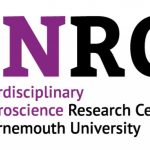 Fourth INRC Symposium: From Clinical Applications to Neuro-Inspired Computation
Fourth INRC Symposium: From Clinical Applications to Neuro-Inspired Computation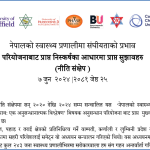 Writing policy briefs
Writing policy briefs Upholding Excellence: The Concordat to Support Research Integrity
Upholding Excellence: The Concordat to Support Research Integrity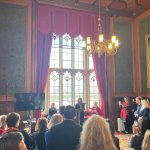 Today’s Documentation Will Serve Tomorrow’s Justice
Today’s Documentation Will Serve Tomorrow’s Justice ECR Funding Open Call: Research Culture & Community Grant – Application Deadline Friday 12 December
ECR Funding Open Call: Research Culture & Community Grant – Application Deadline Friday 12 December MSCA Postdoctoral Fellowships 2025 Call
MSCA Postdoctoral Fellowships 2025 Call ERC Advanced Grant 2025 Webinar
ERC Advanced Grant 2025 Webinar Horizon Europe Work Programme 2025 Published
Horizon Europe Work Programme 2025 Published Horizon Europe 2025 Work Programme pre-Published
Horizon Europe 2025 Work Programme pre-Published Update on UKRO services
Update on UKRO services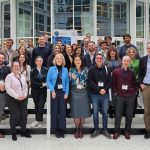 European research project exploring use of ‘virtual twins’ to better manage metabolic associated fatty liver disease
European research project exploring use of ‘virtual twins’ to better manage metabolic associated fatty liver disease